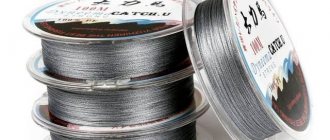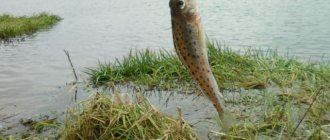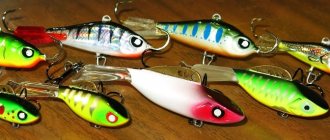In order for a beginner to start winter fishing right away, you need to take preparation seriously and carefully consider the issue of initial equipment. From now on, all this will happen automatically. If the equipment is not properly organized, winter fishing will not bring anything good to a beginner except disappointment, freezing, and fatigue at best. In this article we will tell you where to start, how to go out onto the pond and catch your first fish, as well as important tips for a novice winter fisherman.
Winter fishing - where to start for a beginner
In addition to the varied technical component, ice fishing in winter is an endurance workout. Sometimes you need to spend the whole day in the cold, wind, and at the same time be active. A beginner needs to prepare carefully - this is not a summer fishing rod, when you can visit the reservoir in flip-flops and shorts.
To prevent ice fishing from turning into a disappointment for a beginner, you need to pay close attention not only to the fishing component - fishing rods, tactics, and fishing techniques. It is important to thoroughly prepare yourself for long-term exposure to cold and wind. At the same time, for beginners, not only clothes and fishing rods are important, but also additional elements of equipment, without which winter fishing is impossible.
Therefore, we will also consider the basic, basic accessories for winter fishing for beginners, as well as those elements that are useful, but fishing without them is, in principle, possible. Well, that is, their presence is not necessary, but it is desirable, as it significantly increases the comfort of fishing and expands the angler’s capabilities on the ice.
You need to start winter fishing not with fishing rods and tackle, but with personal equipment. Frost, wind, wet feet and frozen hands will not allow a beginner to fish normally if he does not properly prepare and think through all these nuances.
Winter fishing, unlike summer fishing, is not just fishing itself, but primarily protecting your own body from negative environmental factors. When this is done, you can spend many hours on the ice and do whatever you want.
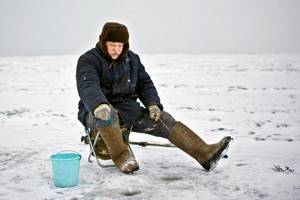
Winter fisherman's equipment
Beginning fishermen, when choosing equipment for ice fishing, do not know where to start. Winter fishing involves harsh weather conditions, in which the hands freeze first. If it is quite acceptable to use mittens or gloves when fishing for a predator with a spoon, then when fishing with jig tackle, when very thin fishing lines are used, this possibility is excluded. The best solution is to use gloves with cut off fingertips. These gloves will allow you to feel the tackle well and protect your hands from freezing.
During winter thaws, puddles can form on the ice, so shoes should be absolutely waterproof. It would be good if winter boots were made of “breathable” materials that can wick away moisture.
You need to wear thermal socks on your feet, and on top of them - socks made of natural wool, which will prevent your feet from freezing even if they get wet.
A very important element in the equipment is thermal underwear, which serves to remove excess moisture from the body and creates maximum comfort for the fisherman. Manufacturers of thermal underwear always indicate at what temperatures their use will be most effective.
For the intermediate layer, it is better to use clothing made from fleece. Such clothing is very light in weight and will not hinder the angler’s movements.
Since precipitation in the form of rain often occurs during winter, outerwear must have high moisture-resistant qualities. Long walks along the snow-covered surface of a reservoir, as well as constant drilling of holes, can be accompanied by active sweating, so a good overalls for winter fishing should quickly remove moisture.
In thaws and light frosts, you can put a knitted hat on your head. If it is very cold outside, it is better to give preference to a hat with earflaps.
What a beginner needs for winter fishing
Preparation for winter fishing for a beginner begins with the selection of clothing equipment. At the same time, you need to understand what is required and why. Just dressing warmly is for walking around the city. A beginner’s entire fishing trip can be ruined by a frozen finger or chapped cheeks. For the convenience of monitoring the condition of your own body in the cold, from the point of view of protection, we will highlight the following critical areas, if they get wet or freeze, fishing is possible only in windless thaws, and even then not for long. If the wind picks up and even a little frost, that’s it, you’ll have to move home.
- Feet - well, you can’t let them get wet and freeze. Novice fishermen should not go on the ice without proper shoes.
- The torso itself is the main clothing, so that it does not blow and does not get wet from rain or wet snow, and in principle retains the body’s heat.
- Gloves and arm area in the fold in front of the hands. In warm, windless weather, many fishermen work without gloves. However, in this case, the cuffs of clothing, no matter what it is, must be tightly tied or tightened with an elastic band in front of the hands, so that wind and water do not get inside further into the hands, under the main protection. It’s even more so in cold and windy weather, and you also need gloves.
- Working with your own hands, constantly taking off your gloves to catch fish or re-bait, putting them on again, warming your hands, making sure they don’t freeze is the working part of any ice fishing. You need to understand that during winter fishing, your hands are constantly in the cold; this is the fisherman’s main working tool. You need to be careful not to accidentally get frostbite in the wind and frost.
- Neck and head area. It’s easier here - a good hat, a hood in case of wind, behind which you can hide almost your entire face, a high collar or a design of outerwear that reliably protects your entire neck. In windy, frosty weather, only the eyes of a novice fisherman should look out.
We caution against drinking alcoholic beverages! After consumption, it temporarily becomes warmer - but this is a deceptive illusion. Soon the blood vessels will narrow, and the body will begin to freeze more than it would when sober, and the person does not even notice this because of the hops and euphoria. It is better to warm up with hot coffee or strong tea from a thermos.
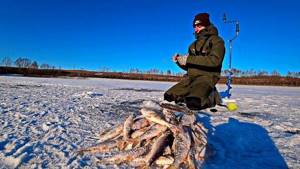
The right clothes
So, preparing for winter fishing for a beginner begins with thinking about and selecting personal clothing. Elements of personal equipment and equipment for winter fishing for beginners:
- Special shoes. The best option is PVC fishing winter boots with warm liners, as well as burkas with rubberized galoshes. In the simplest old-fashioned version - felt boots and rubber galoshes, or stockings from the Soviet army unit on top. No boots or sneakers. You can't cheat on this element. Rubber is required. First, the feet come into contact with wet slush every time a hole is drilled. Secondly, you often have to fish when there is a lot of water on the ice above, sometimes several centimeters everywhere. You can buy it at any fishing store. You need to take a larger size so that they fit freely on your foot with a warm sock and liner, but do not dangle. If it’s tight, your feet will freeze.
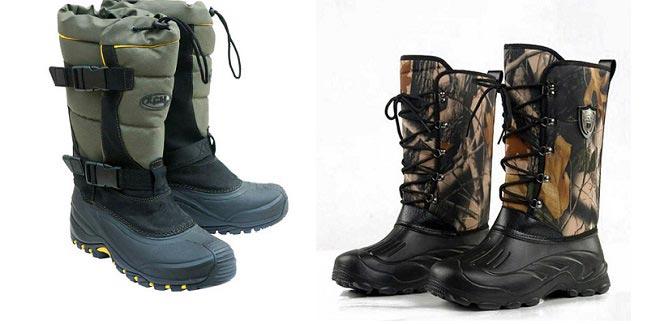
- Warm socks. Below are regular cotton socks, not synthetics. Synthetics can only be used for special sports ones, but it is expensive. On top - warm woolen socks.
- Thermal underwear. You can buy special winter thermal underwear - it is now available and inexpensive. The popular option is again cotton shorts and a T-shirt, and on top – something thicker, underpants or a turtleneck.
- The next layer is insulation. This could be a fleece or wool sweater. Maybe two. The more layers, the warmer, but harder to wear. Mobility decreases.
- A good option for beginners is a down or synthetic padded vest. The body is warm and the arms are mobile.
- Outerwear. The best option for beginners is a special winter suit for fishing. But this is if you have the money to buy it. If not, a regular winter jacket will do, long (to cover the butt and groin) and with a hood. Grandfather's old sheepskin coats and fur coats are also suitable - but they are heavy. Many winter roads have outerwear of the usual padded two-piece, which is easy to find - military or construction padded jackets and a pea coat.
- The outer trousers are high with suspenders rather than a belt. Special fishing or hunting, at least construction or military quilted jackets.
- Gloves - for a beginner, at least ordinary Chinese ones with synthetic padding. But better - fishing, waterproof ones. There are models with folding fingers. In relatively warm weather, thin wool ones are also suitable. It is important not to get the gloves wet - otherwise it will become impossible to use them in the cold. Therefore, it is better for a novice fisherman to have spare ones in his box.
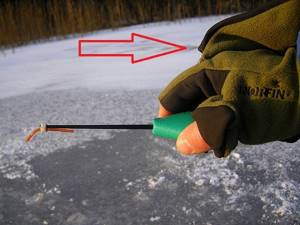
- Hat, scarf, balaclava - at your discretion, depending on the weather, as long as your head doesn’t freeze.
The clothing for a beginner winter hiker is selected depending on the weather and fishing method. For fishing with girders and stationary fishing rods, we dress to the maximum - you will have to sit still for a long time. When actively moving with a reel or spinner, it’s easier so as not to sweat when you walk. If you start to sweat while fishing, you need to reduce your movements in speed and intensity.
You can't sweat - you'll freeze even more later. Therefore, modern clothing for fishing and hunting is preferable. The right set wicks moisture away from the body, but keeps cold and water out. These are various kinds of membranes, soft shells and other things.
We keep an eye on the brush area, especially if the angler is a beginner. It should be tightened with straps, elastic bands or the design of the outerwear itself. Further control will occur automatically. If you do not have a windproof and waterproof suit, you also need a top layer to protect against water and wind. An army slide protects from the wind, and special raincoats and capes protect from water.

Winter fishermen jokingly call themselves penguins. Take a closer look at them and you will understand why. Some are dressed in such a way that they move by swaying from side to side. And this is not without reason. It is not the one who is hardened who does not freeze, but the one who dresses well. If there is a body of water nearby that is frequented by fishermen, just take a walk and see who is wearing what and how they are equipped. At the same time, check your own clothes. If a few hours are comfortable, you can start fishing.
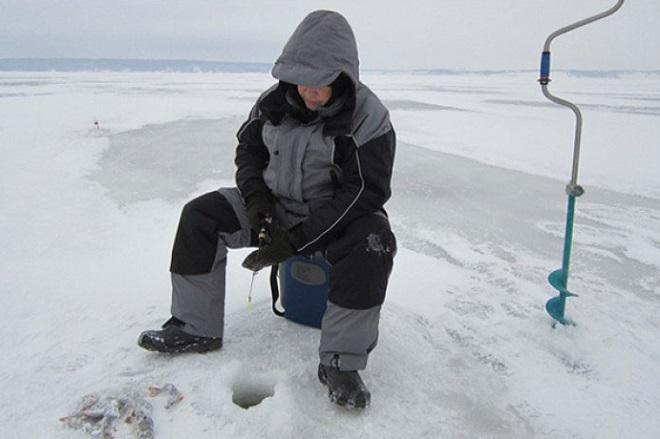
What clothes and shoes are needed
Fishing always involves keeping your body in one position for a long time, but if in summer it’s quite simple to sit by the river with a fishing rod, then in winter you can completely freeze within 20–30 minutes. Warm boots, a thermal suit, good gloves and a hat will help prevent frostbite and the unpleasant consequences associated with it.
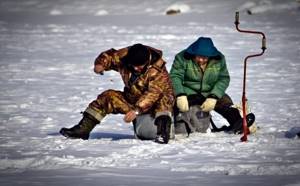
Boots
Regardless of what kind of shoes you choose for your trip, they must be light, warm and waterproof. Felt boots have long been considered a good option for winter fishing, and to prevent them from getting wet, high rubberized galoshes are worn over them. This set, in combination with thermal socks or simple wool socks, is quite capable of protecting a beginner’s feet from freezing.
Did you know? The record for the longest cast of gear was set by German fisherman Walter Kimmerow, who managed to throw a 30-gram weight with bait to 176 meters.
If winter fishing is not a rare activity, it makes sense to purchase special insulated and rubberized boots made from materials that can withstand the harshest winters. In addition, their thick soles do not slip on ice, which means, in addition to high-quality insulation, you will also gain ease of movement on a frozen body of water.

Costume
An ordinary winter jacket for ice-hole fishing is not suitable, since in most cases such products do not have a sufficient level of wind and moisture resistance. Moreover, in combination with low-rise pants, such outerwear leaves the lumbar area exposed, where the frosty wind freely enters.
Important! Under your outerwear you should wear thermal underwear, a warm sweater, and equally warm woolen pants.
Also, for regular winter fishing, it is worth purchasing a special water- and wind-resistant suit, especially since many models have inserts on the surface that keep a person afloat if the ice breaks and the fisherman falls into the water. A warm hat with inserts on the ears, which additionally needs to be tied with the same warm scarf, will help protect your head from frost and wind. Even if it suddenly turns out to be wind-blown, the hood of the jacket should eliminate this drawback.
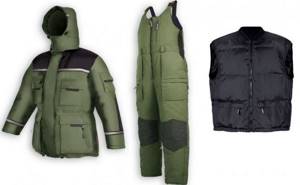
For better insulation, experienced fishermen advise using closed overalls, over which it would be better to wear a short fur coat (just above the knees).
Gloves
When it comes to choosing protective gloves for your hands, there is no consensus among fishermen, since the ease of handling a fishing rod is important here, and thick suit-type gloves are not suitable for everyone. The most comfortable are thick woolen products with cut off tips on the thumb and index fingers.
Important! If possible, always bring several pairs of gloves of different thicknesses. If your hands get cold in thinner but more comfortable ones, you can always warm up in thick ski boots.
You can also use down mittens, which can be easily removed from your hands if necessary. Often, mittens are sewn to the ends of the lace and passed inside the sleeves, which will prevent them from even being accidentally thrown onto the ice.
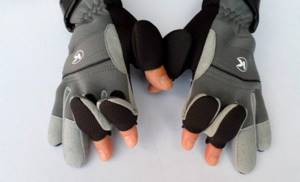
Basic equipment for a beginner subglacier
So, we are dressed and shod - we can proceed directly to the fishing equipment. What else does a beginner need for ice fishing? Regardless of the fishing method, ice fishing means drilling holes. To do this you need a special tool:
- Ice drill or pick.
- Spoon and slotted spoon for scraping out sludge.
- A folding chair, but better - a special fishing box for winter fishing with a foam seat.
- Mothworm, if we fish with baited rods.
- Feeder for bait.
- Thermos with tea or coffee.
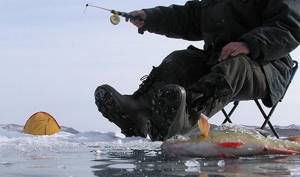
Ice pick and ice screw
The ice pick is a piercing and chopping instrument. An ice pick can be used to make holes in thin ice. Also, in the first ice, it is the ice pick that taps the ice in front of you. An ice pick with a short handle is needed to widen the hole if necessary. However, for a beginner it is better to use an ice auger. You can buy an ax later if you need it, but a beginner is nowhere without a drill.
- A fishing drill is a rotating tool with knives at the end and an auger so that the crumbs of ice destroyed during drilling come out. With a drill you can drill through ice of any thickness, as long as the length of the handle allows.
- The drill knives have a cover. Ice auger knives are a critical point. They must be sharpened correctly. You should not hit the ice with the drill, drill into the sand, or hit the rock bottom in shallow water - novice fishermen need to be especially careful about this. You should always monitor the performance of your knives.
- There are now many different drills on the market, both ours and foreign ones. For beginners, I recommend first purchasing a Barnaul Tonar drill with an auger diameter of 130 mm. This size is universal for almost any fish. As a last resort, you can drill double or triple holes. If you only catch small things, 80-100 mm will do, it’s easier and faster to drill this way. Why Tonar? It’s simple - a set of replacement knives for it is sold in any fishing store for a ridiculous 100-200 rubles. Knives from foreign top-end drills cost the same as the entire Tonar, and you can’t quickly get them everywhere.
- When fishing, always carry a set of replacement knives and a screwdriver for replacing them (a key if they are bolted). Otherwise, if the knives fail and it is impossible to replace them on the spot, you will have to stop fishing.
Detailed article about winter drills for fishing
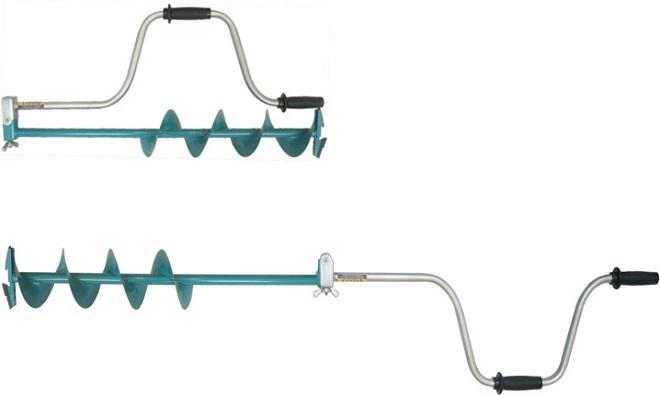
Skimmer
A scoop spoon with holes is used to remove slush from the hole. This is also a mandatory element of equipment. Only in rare cases can it not be used - but this is most likely not for novice anglers. But then you need a stick to form a hole in the sludge for lowering the equipment.
In cold weather, the angler constantly works with a slotted spoon to clear out the ice that forms in the holes. When fishing for girders, you can also get live bait from the canal, so as not to get your hands wet. It is better to choose a reliable spoon with a strong wooden or plastic handle. It must not drown if it accidentally gurgles into the hole.
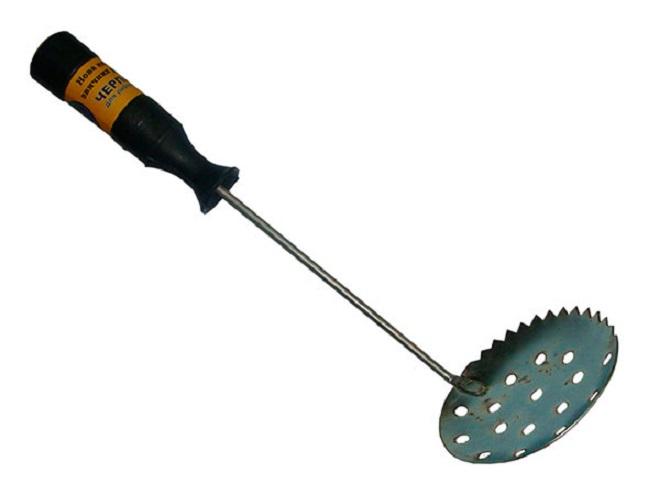
Mothworm
When using bloodworms, it is important not to freeze the larvae. A moth box is a special polystyrene box where the larvae are stored. The box is stored in the inside pocket to keep it warm. In cold weather you need to take it out, quickly take the bloodworms and put it away again. And so every time. Only during a thaw or when fishing in a tent, if it’s warm there, you don’t have to remove the bait every time, but leave it nearby in order to quickly replant the gear.
A bloodworm costs a penny and is also available in the assortment of any fishing goods seller. At home we store it with the larvae in the refrigerator; it is also important not to spoil the bloodworms on the way to fishing. Read more about how to store bloodworms for ice fishing
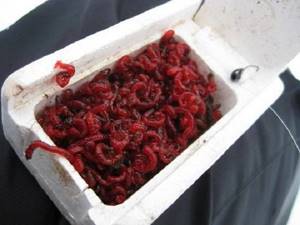
Thermos and food
Perhaps not the most obvious piece of ice fishing equipment for beginners is a thermos with a hot drink and some food. However, this is important specifically for long-term exits. The body spends a lot of energy moving and staying warm. There is nothing better than a mug of hot tea in the cold, snacking on a sandwich with lard made from black bread. Some fishermen take gas burners and frying pans with them to the ice, organizing entire picnics. This is nice, but not necessary. But a beginner needs a thermos with tea, at least for the consumption of liquid to avoid dehydration.
Feeder
If you fish with a jig with a nozzle or a stationary fishing rod, you will need a feeder. Many fishing tactics require the mandatory use of bait. A regular feeder is a plastic or metal cone with holes and a lid that flips when pulled. The feeder is tied to the line of a strong fishing rod with a reel in order to lower it to the fishing point and open it at the bottom, pouring out the bait.

Equipment
Warm clothing is not the only mandatory attribute of winter fishing. The main tools will be a device for organizing an ice hole, a fisherman's box, fishing tackle, all kinds of bait and lures, skimmers and feeders. Also, do not forget about food for the fisherman himself, because catching fish takes more than one hour.
You might find this information useful on how to fry pink salmon steak in a frying pan.
Of course, the choice of each of the listed tools is based on the personal preferences of the person himself, but for productive fishing one should not forget about the leading characteristics of such equipment.
Video: Buying equipment for ice fishing

Hole Tools
The thickness of the ice is often several tens of centimeters, so in order to create an ice hole suitable for casting, it is worth preparing the appropriate tool. Usually it turns out to be a so-called ice drill, which, with its compact size when folded, copes well with the task already on site.
Important! In the process of organizing the hole, the blades of the ice drill may become dull or break, so it is worth having a spare set of knives for the tool.
Auger ice drills are widely used today, although gasoline models and varieties with electric drive are no less popular. The latter significantly speed up the drilling process, however, they weigh several times more than manual auger products and, accordingly, have a high cost.
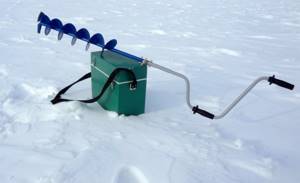
Fishing box
This accessory always performs several functions at once, which is why it is considered an indispensable thing for both winter and summer fishing. At the initial stages, only fishing gear taken with them is stored in it, then the caught fish is put inside, and during the process of catching it, it is used as a comfortable chair.
When choosing such a product, you should give preference to containers divided into several compartments so that all the contents do not get tangled with each other. In addition, it is good if the multifunctional fishing box is relatively light in weight, otherwise carrying it will be very problematic.
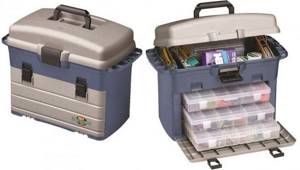
The lid of the box may contain additional compartments for fishing line and small fishing accessories, the main thing is that they are tightly closed with lids.
Tackle
The main thing that is required for winter fishing is a special winter fishing rod, a suitable fishing line, a float and hooks. Unlike a standard long rod, winter varieties are much shorter and reach a maximum length of no more than 15–25 cm (in rare cases, up to 70 cm). Their handles are often made of non-thermal materials such as wood, foam or cork.
Did you know? Spider webs, especially the varieties of spiders from South America, are deservedly considered one of the most durable natural materials.
Noticing this fact, fishermen from New Guinea began to use it to weave fishing nets, although the finished product is not particularly durable.
Inertial or inertial-free models are selected for the role of a reel, and the top of the whip is additionally equipped with a nod (bite alarm). The winter version of the fishing line is thinner than the standard summer one: its thickness for float or jig tackle ranges from 0.08 mm to 0.12 mm. If you plan to use a spoon, then you will need thicker options - 0.14–0.16 mm, so that a predatory fish caught on the bait does not tear it.
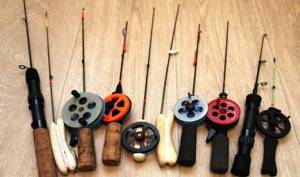
As for the color of the product, it is better if it is colorless, but it is better not to use green or very dark fishing lines. It is not recommended to use braided line, since at low temperatures it becomes less plastic and has inferior characteristics to monofilament line. Ideally, you should take with you several types of fishing line of different thicknesses and, on the spot, choose the most suitable one for yourself, if necessary, changing it several times a day.
Floats and hooks are deservedly considered equally important gear. The first ones can be cone-shaped or cylindrical and always painted in bright colors.

To make fishing more productive, there should be several sets of such fishing rods and other gear included in their kit, especially if you plan to organize 2-3 holes at once.
Of course, they are useless when fishing with a jig, but many fishermen still use ordinary float rods. The hooks must be thin and sharp so that the bait used does not lose its attractiveness when hooked. You can pull small fish out of the hole using products No. 3–7, but for predatory fish you will need hooks No. 8–10.
Groundbaits and lures
One of the fisherman's first assistants is the spoon, which lures fish to the hook. However, during winter fishing it is not always convenient to use it, so only experienced fishermen who hunt for pike, pike perch, chub and perch resort to trolling. The technique of using a spinner is individual in each case.

Much more popular for winter fishing will be standard bait in the form of bloodworms, maggots, caddis flies or wax moths, which can be purchased at almost any specialized fishing store. Bloodworms are often used to feed fish in ice holes, for which several larvae are crushed in water.
Find out also how to make casseroles with pink salmon.
It is better to go for large predatory fish with small fish, but if you couldn’t find it in advance, you can always catch such bait in the same body of water using the above bait or artificial bait. Silicone, plastic and rubber bright fish are almost as likely to attract predators as real live ones, so in any case it is worth having several bait options.
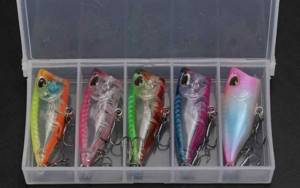
Mormyshka
A jig is a small artificial bait with a hook hidden in it, the dimensions of which range from 1.5–6 mm. The material of manufacture, color and shape of such a product can be very diverse: from lead varieties to tungsten, tin and ordinary metal, decorated with bright luminescent paints.
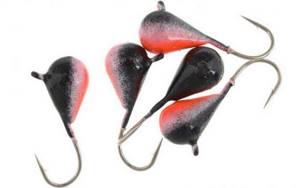
To study the preferences of fish in a specific fishing location, it is advisable for a fisherman to have at least 10 different jigs.
Secondary equipment
In addition to the basic equipment described above, you can also take with you the so-called secondary equipment, which includes the following items:
- depth gauge — a weight tied to a cord with markings, which is used to determine the depth of a reservoir at a specific point;
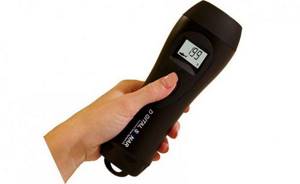
- extractor — a tool for removing a hook stuck in a fish’s mouth (can be useful in cases where a predator has swallowed the hook deeply and you need to get it out without getting hurt by the sharp teeth of the fish);

- separate container for storing used bait (this can be a very small box, the main requirement for which is to keep the cold out so that the bloodworms or maggots do not die and remain more appetizing to the fish);
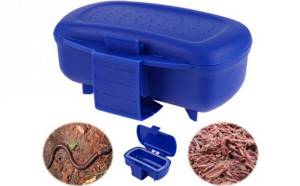
- pickle - a tool with a long handle and a steel pointed end, with which it is convenient to check the thickness of the ice (especially relevant if you go fishing in an unknown place and do not know whether the ice is frozen evenly);
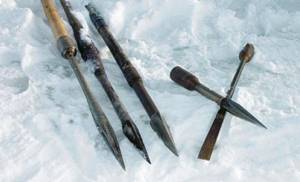
- gaff (a hook with a wooden handle) is a useful device when catching large fish, as it helps to get it out of the hole.
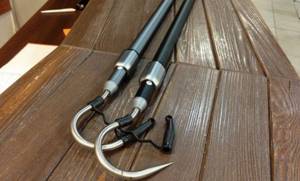
Food
In addition to standard sandwiches with sausage or other fillings, you should definitely take with you a large thermos with hot tea or coffee when going winter fishing, which will help you warm up between bites. If possible, you can prepare a light soup in a thermos, and also take crackers or cookies with you for a light snack.
We suggest you read the information on how to marinate pink salmon in soy sauce.
Feeder
This special device is a convenient thing for baiting fish swimming at different depths. The design and shape of the product do not play a fundamental role; the main thing is to tie it to a fishing line at the required level, fill it with complementary food and lower it into the hole in order to collect the fish at one point. In the future, the float and sinker will also have to be set in accordance with the depth of the preliminary location of the feeder.
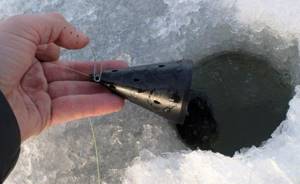
Organization of carrying equipment
So, we are dressed, with an ice screw, a slotted spoon and some gear, about which we can continue the conversation endlessly. You can already fish. Let's touch on one more point for beginners. For a couple of hours with one fishing rod, you can go out on the ice lightly - a fishing rod and a bloodworm in your pocket. There is also a box with spare jigs (spinners) somewhere. In the backpack there is a thermos and a slotted spoon, in the hand there is an ice screw.
- However, for more or less serious fishing you also need a fishing box. Carrying a high chair and a bunch of boxes in a backpack is inconvenient. A special winter box is a universal solution. All gear and spare parts are stored inside it. If the catches are small, the fish are also added there. Even a small thermos will fit.
- A backpack is not needed. A winter fisherman's bag is exactly a box. In addition to carrying gear and swag, you can also sit on it while fishing - no need to carry an extra chair with you. The box can be carried with a belt over the shoulder or in a sled.
- If you need to walk a lot on a pond, or to reach it, you will need a plastic drag sled. Basically, it's just a plastic trough with a string. We put all the swag in a winter fishing sled - a box, a drill, a thermos and food, a slotted spoon. And we drag behind us by the rope. This is the most convenient way to move when ice fishing.
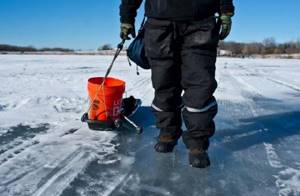
SOS! Or help yourself
The list of emergencies on ice, fortunately, is small - we are not in Australia, where everything is dangerous. However, it is quite possible:
- fall through the ice;
- become hypothermic;
- get lost.
The first assistant of someone who has fallen through the ice is an ice pick. You can throw away everything else, but it’s better to hold the ice pick firmly in your hands, turning it horizontally. This way there is a chance of getting caught on the edges of the break. Well, in order to avoid getting into an area where the ice is unreliable, an ice pick will also do - check your path with it.
In case the ice pick does not help and you find yourself in the water, carry rescue awls with you. They resemble a jump rope: only instead of handles, there are handles with strong steel or titanium awls. These make it easy to get caught on the ice. Experienced fishermen use instead ordinary awls connected with rope or paracord. But factory awls will be more reliable. As a last resort, if you don’t have anything at hand and it’s time to hit the ice, use a couple of two-hundred-dollar nails.
Being hypothermic is more dangerous than simply freezing. Hypothermia leads to slow blood circulation, lethargy, dizziness and drowsiness. As soon as you feel that you are falling asleep, you don’t want to move (but you really want to sit down, take a nap) - act. Call for help! And, if you can’t move at all, wrap yourself in a heat-saving blanket. You must take it with you: when folded, it fits in your pocket.

The thermal blanket is warm: you can sit, drink tea and wait for help
Getting lost in the “white desert” somewhere on a reservoir or even a wide river is as easy as shelling pears. If you cannot find your tracks to the fishing spot even with a flashlight, stay in the tent. Just throw the flare next to her, half an hour to an hour after calling for help. Even in heavy snow, its light is quite visible. Bringing two or three flares with you while fishing will increase the chances that you will be found quickly.
Even in the digital age, don't forget about the compass. The phone can be dropped, broken, or drowned, but this does not threaten the compass. Just keep it in your pocket, not in your tent, and before going out on the ice, look on which side the shore will be.
To the table of contents >>
Advanced Gear for Beginners
Let's touch on some more types of equipment for winter fishing, which a beginner will still purchase or use later. Maybe beginners will need some of this right away. List of minor, but sometimes necessary, winter fishing accessories for beginners:
- A tent, or at least a protective wing. This is wind protection. An ice fishing tent is good for long periods of sitting in one place. The cheapest option is a Chinese folding bed, it costs one and a half thousand, it unfolds and assembles in seconds. However, it is not stable in strong winds. The main evil when fishing in winter is the wind. Even at -30 you can sit on the ice – in the calm. However, if you’re not used to it, you won’t be able to sit in a strong wind for even an hour, even at minus 10. If you don’t have a tent and you’re a tough fisherman, you can sit simply with your back to the wind. A more comfortable option is to use a more expensive gust-resistant tent. However, if you are chasing pike perch or other fish in constant search, you don’t need a tent, since the point of fishing is to constantly move and catch new places.
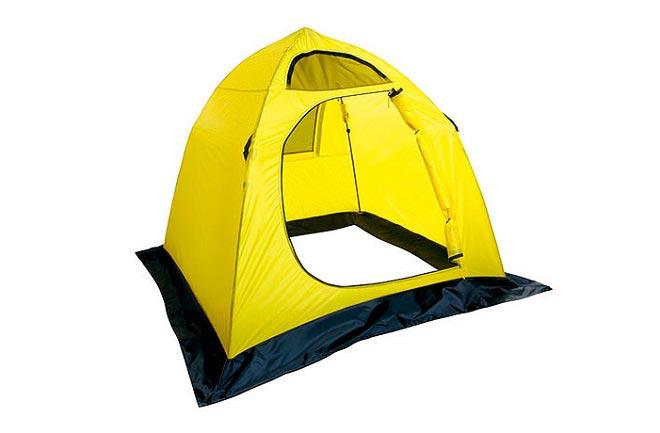
- To install a tent on ice you need special screws.
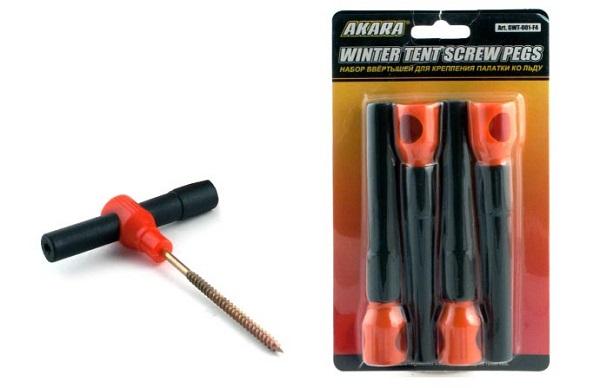
- Heating in a tent - for a beginner, at least an ordinary candle or a simple gas burner. Burners should only be used in tents with ventilation or with an unfastened door, otherwise you may burn to death. Every winter, the sad statistics of fishermen who died while sleeping on the ice in Chinese non-breathable tents from the burner are replenished.
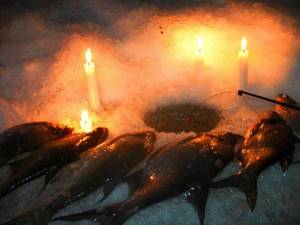
- Foam knee pads are useful for beginners during active fishing when they are biting one after another. At such moments, it is convenient to sit on your knees in front of the hole, and not on the box.
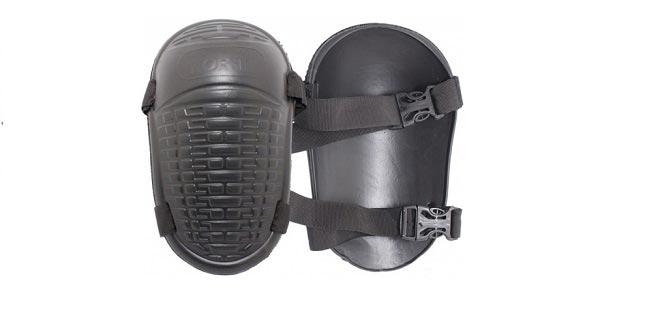
- Hook - for retrieving large fish, especially when the ice is thick. You won’t be able to pull out a bream stuck at the bottom of a hole with a meter-thick layer of ice at the end of winter.
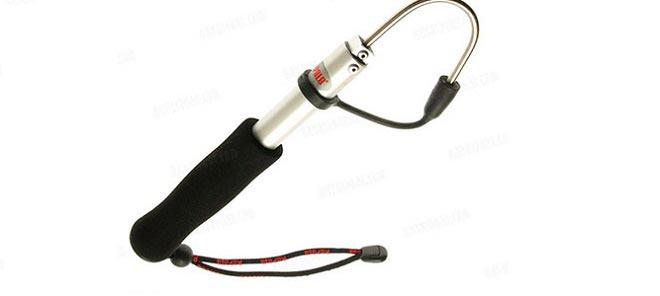
- Extractor and yawner - useful for beginning pike hunters. Struggling to remove hooks in the toothy mouth of a predator is quite a task in the summer, and even more so in the winter.
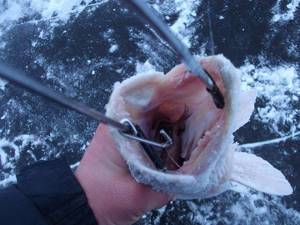
- An echo sounder, a camera, a depth gauge - already for notorious winter roads, whose tactics are always based on studying the topography of the bottom of the reservoir.
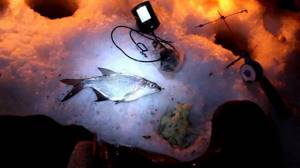
Additional equipment
In addition to the tools and materials described above, the fisherman can take with him some other products that, although they will not make fishing more successful, can at the same time increase the comfort of a person’s stay on the ice.
This group of equipment includes a chemical heating pad (can even be found in the form of shoe inserts), fishing glasses for a better view of the water in the ice hole (on a bright sunny day, the glare appearing on the surface strains the eyes) and a device for sharpening used hooks on the spot.
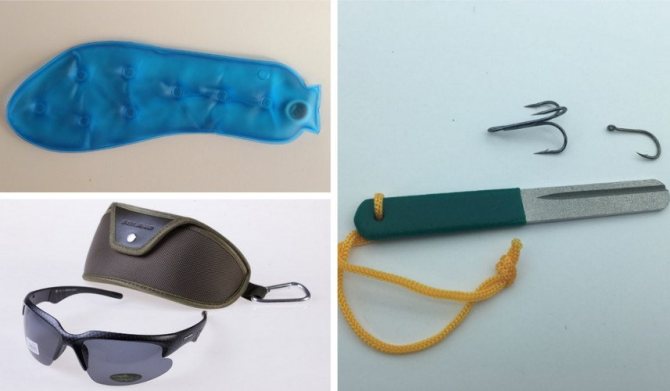
Of course, the list of necessary things for a novice fisherman is quite long, but do not forget that spending time near a pond in summer cannot be compared with the situation in winter, so in order not to risk your health, you should listen to the advice of experienced fishermen, dress warmly and prepare in advance the most suitable ones for the season tackle and other equipment.
Fishing methods
Here we will only touch on a roughly superficial description of possible fishing methods with which to start. The world of winter fishing is vast - all dozens of articles on our website are devoted to this issue. You can’t learn all this in five minutes - but only over time, reinforced by personal practice and experience on the reservoir. Winter fishing for a beginner will most likely begin with one of the following methods:
- Conventional fishing rods for spot fishing from the bottom, with a float or nod.
- A jig is a fishing rod with a nod; you need to attract fish with a special action of the bait. Bait is placed on the hook.
- Reelless – a jig for playing without natural bait.
- Winter lure - for predators with spoons, balancers and other baits.
- Zherlitsy - fishing on stands of various designs.
More information about the types of winter gear: link coming soon
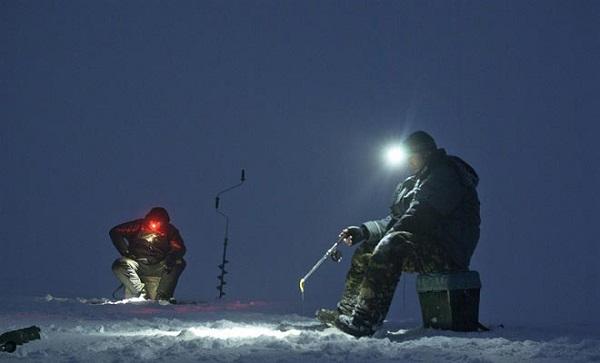
Stationary fishing rods
The point of fishing is that the fisherman looks for a promising place, drills holes, and if necessary, feeds them. Usually, ice fishing for beginners starts with just such simple gear. Gear is installed - fishing rods with a jig (hook and sinker at the end). On the hooks there is bait, bloodworms or maggots. Fishing rods can be float or nod.
The float is overloaded to be underwater. The summer option, when the float sticks out, is not suitable, it will simply freeze in the cold. When bitten, the submerged float usually floats up, while the nod usually rises or twitches. Article about equipment for winter fishing rods
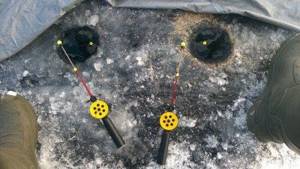
Attachment jig
This is already catching the game. The nod is carefully selected according to the weight of the jig. With certain movements of the hand, the jig with a bloodworm on the hook twitches in the water, attracting fish. Fishing tactics are usually search. The more you move, the more you will catch. The equipment used is thin, on a line of 0.1-0.14 mm, depending on the intended production. Read more about fishing with a jig with bloodworms

Mothless
This is a development of the attached jig. Only bloodworms and other attachments are not used. The fish are attracted by the correct action of the bait. Here, finely tuned equipment and correct bait play are even more important. Lessons and tips on winter fishing for beginners without a reel can be found in abundance on the Internet and on YouTube, as well as on other fishing methods. Article about baitless fishing in winter

Under-ice fishing rods for currents
On large rivers with currents, ordinary light fishing rods will not hold up in the current. Here you need tackle with a heavy sinker - a fishing rod. There can be many options for rigs, depending on the fishing conditions. You need a more powerful fishing rod, one that can stand still under the pressure of the current on the line. Article about winter fishing with ice donks
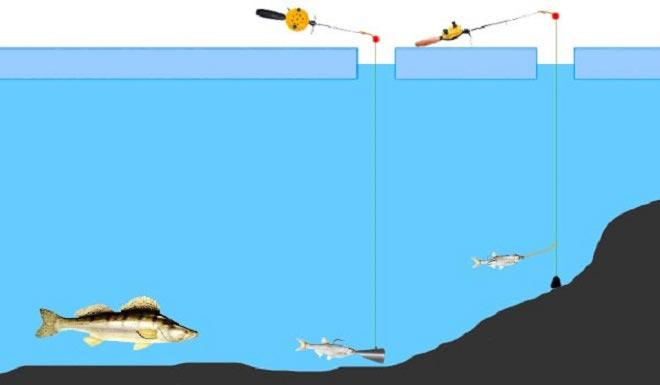
Winter sparkle
Probably half of all ice fishermen are spinners. This is an analogue of spinning, only in winter from ice. An artificial predator bait is attached to a fishing rod with a reel or reels. Fishing tactics are usually also search tactics. The game is a certain twitching and stretching. This is also a huge fishing direction with its own subtleties and secrets. Article about fishing with balance beams in winter from ice

Zherlitsy
Posts, flags, and bets work mainly for pike with live bait. Here, in addition to the gear itself, you need to take care of the bait. Often you need to devote a separate fishing trip to catching live bait. Experienced garrison fishermen have a whole system for winter storage of live bait and its preparation. Fishing with girders is not as easy as it seems. Fishing trips are often laborious, and you run across the ice no less than with a spinner or jig. Article about ice fishing for predators with a zherlitsa
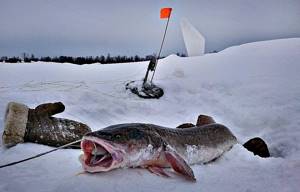
Warm clothes
To avoid hypothermia during long hours in nature, you need to take care of winter equipment. Clothing should be heat-saving, water- and windproof, few layers, comfortable for movement and one size larger to create an air gap.
The domestic market offers the use of thermal underwear. It retains heat well and removes moisture from the body, while maintaining a constant temperature and microclimate.
The outerwear set includes a winter jacket and warm trousers. Some fishing enthusiasts in the winter season prefer down suits, consisting of overalls and a jacket. They are made of multi-layer waterproof fabric that provides comfort at the lowest temperatures.
There are products with special inserts that allow you to hold a person on the water if you get into an ice hole.
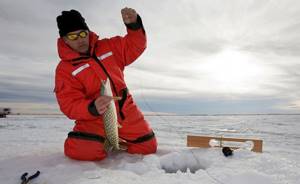
Insulated hats with fur or fleece and classic hats with earflaps are suitable as headwear. To protect against oncoming air flow when riding a motorized sled, balaclavas and face masks are used to protect against strong gusts of wind or snowstorms. They are worn under the main dress, covering most of the head, leaving only the eyes open.
What needs to be carefully prepared is shoes that protect your feet from frost, cold and moisture. Fans of winter fishing will find boots, shoes and ankle boots with insulated layers and thick soles that do not slip on the surface. Many fishermen still use felt boots. They are warm, light and comfortable, but with one drawback: when walking in wet snow or water, they get wet.
You should also not forget about a warm sweater, fur or wool socks, as well as gloves with the tops of the index and thumb cut off or down mittens that can be easily removed from the hand.
Theoretical preparation
A novice fisherman needs to constantly study the issue. There are many winter fishing lessons available in literature and on the Internet. Our site specializes in winter fishing. Everything you need in terms of information can be found here. Various explanations on winter fishing for dummies are also posted on YouTube. A beginner needs to read, watch and study all this, in his chosen direction. Naturally, you also need to get out onto the pond more often - only practice will turn a beginner into an experienced fisherman.
Subscribe to the channel:
My YouTube channel RYBAFAN on fishing:
We're OK
Optional equipment
Additional equipment includes a heating device and a tent. They improve conditions in the cold. A vehicle is required to transport them. Many fishermen buy a device to find fish - an echo sounder.
Tent
There are 3 types of tents:
- dome;
- frame;
- automatic.
Dome models are considered budget-friendly. Automatic products are practical, while frame products are reliable. Tents protect from wind and frost. Professional fishermen advise purchasing domestically produced products, since Chinese designs are not quickly installed and assembly is problematic.
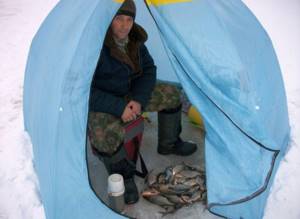
Read: How to choose a cube tent: characteristics and rating of models
Heater
The tent for winter fishing is heated using a heater. There are 2 types of heating devices:
- infrared;
- gas.
Infrared equipment is more efficient. It is capable of heating large tents using rays. The device connects to a propane cylinder; the piezo ignition system ensures quick and easy starting in any conditions.
The simplest and most convenient is a tourist gas heater. Its operating time is 3−5 hours depending on the model.
Choose a frost-resistant box
Before talking about gear, you should first decide on a box . It is advisable to purchase a box from well-known manufacturers - they use frost-resistant plastic. The Chinese usually use simple, low-quality plastic, and when fishing at minus 10-13°, the box can crack. If factory-made plastic is used, Chinese boxes, in principle, can also be quite good, able to withstand sub-zero temperatures, but it is better not to take risks and take proven options. There is another option: relatively recently they began to produce very good polystyrene boxes. Their advantage is that they are lightweight, do not break or crack at very low temperatures, and retain heat. And when you sit on such a box, it gives off heat and the person does not freeze. The interior of the polystyrene box is a thermos: if you keep food there, it will remain warm for a long time, and when collecting fish, it will maintain a cold temperature.
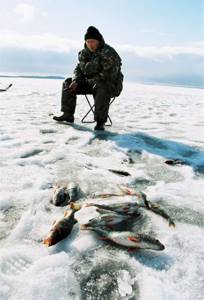
Winter fishing lines don't come cheap!
When buying winter fishing rods , it is advisable to choose ones with a foam handle: the foam transfers heat to the hand, and it does not freeze so much. Plastic fishing rods are also good, but foam always comes first. People prefer it precisely because of its warmth.
Much attention should be paid to the fishing line. It is better to buy it of high quality, from good manufacturers, and in no case cheap. Remember: winter fishing line cannot be cheap! Ingredients that are added to winter fishing line (for example, copolymer) affect its strength: when friction with the hole, it heats up less. There is no point in adding this material to summer fishing line. If the price of winter fishing line is low, it means that its tests are either too high, or summer fishing line is being sold under the guise of winter fishing line.
There should also be a box for bloodworms . The best option is made of foam or wood. You should not buy a plastic box - bloodworms and maggots can freeze in it.
jigs for winter fishing; everyone has different preferences. Tungsten is heavier than lead and sinks faster at depth, i.e. it reaches the bottom faster, which is why it outperforms lead. If the bite is intense, then it is better to use tungsten jigs. Lead has its own advantage over tungsten: due to its lightness, it sinks worse, but it plays better. In principle, every angler should have both a lead and a tungsten jig.
You can also note the nozzle-free jig, on which you don’t need to hang anything - it is already equipped with a movable cambric or bead. It is also interesting to catch: when the bite is intense, you don’t have to waste time putting on a bloodworm or a white one.
Winter fishing for beginners - tips from experienced fishermen
Winter fishing is one of the most favorite activities in the life of an avid fisherman.
Experienced fishermen always prepare for the winter biting period diligently and in advance. The bite period is determined by three ice positions. The first stage of fishing always occurs on the first ice. During this period the perch bite is very good. The second stage occurs in the middle of nowhere and fishing becomes difficult. And in the third stage of the last ice you can catch not only perch, but even pike.
To be prepared for fishing and not miss your chance for a big catch at the very last moment, you should be well prepared for winter fishing.
Here's what experienced fishermen advise on this matter.
Clothes for winter fishing
The first and main point in winter fishing is good clothing. Beginners often make the mistake of trying to put on as many warm clothes as possible.
And the point is not at all in them - but in the correct thermoregulation of the body. And a large number of thick sweaters do not in any way contribute to comfort during physical activity that involves active activities.
Therefore, the main advice when choosing clothes is to choose the most comfortable, warm clothes that do not restrict your mobility.
The body should breathe well, and sweat should be removed from the body as much as possible - feel free to exclude synthetics. Only woolen items and natural underwear should be close to the skin to avoid hypothermia and frostbite. Wear wool underwear and a knit turtleneck sweater. Please note that things should not be too tight.
Outerwear is a proven grandfather's version - a sheepskin coat with a belt, which, when the belt is removed, gives freedom of movement and reliably protects from the cold. Don't forget a raincoat in case of rain or snow. If these things are not to your liking, then look for suitable analogues in a sportswear store, paying attention to products for skiing.
Take care of good waterproof shoes that securely fix your feet - these can be special boots for winter fishing with high thick soles, with wool inserts or another old-fashioned option.
You should take boots two or even three sizes larger so that your feet feel comfortable when putting on various woolen inserts and insulating elements. An economical option is deep galoshes with felt boots.
They can often be found among winter fishing enthusiasts.
An important point is a good knitted hat. Experienced fishermen do not recommend using a hat with earflaps for these purposes, as it quickly gets wet and becomes heavy, and freezes easily in the cold. Take a deep-fitting, tightly knitted hat that covers your ears well and fits your head, and you won't go wrong.
Tackle for winter fishing
Experienced fishermen give a lot of advice about the gear that is needed for fishing in winter. They all boil down to the fact that you need to carefully select those items that will be needed in the first place, from those that will burden you and take up extra space in your backpack.
The first is the fishing rod. There are three types of fishing rods for winter fishing, each of which, if you have certain skills, is suitable for both an experienced fisherman and a beginner.
Fishing rods with jigs and spinners. Fishing rods with floats. Winter girders.
When choosing between these three types, remember that the most important thing is that the rod is light and comfortable. Many fishermen prefer the so-called homemade “balalaika” to all of the listed types. Since it allows you to search for fish at different depths across the entire surface of the reservoir.
For beginners, it is better to choose a short fishing rod equipped with a reel that will allow you to independently adjust the length of the fishing line.
The second is bait. Try to get several types of bait in small quantities. Suitable for these purposes:
small bloodworms - the most common bait option in fishing stores; pieces of worms or fresh fish - which are not so easy to get in winter; dragonfly larvae - they are somewhat more difficult to find than bloodworms, but they are available in special stores for fishermen and pet stores as food for small reptiles.
Third, an additional tool for drilling a hole is an ice drill and an ice pick.
The fourth is containers for fish. It is best to use special metal mesh with handles, but never modern plastic bags.
Advice from experienced fishermen - add a rod whip to your gear; it will control the amplitude of the nod swing and allow you to detect fish that have bitten the bait.
Add a thermos of hot tea with lemon and sugar and sandwiches in case you get hungry. For longer fishing trips, it is worth preparing much more carefully and taking care of more additional equipment and transport.
Fishing - tips from experienced anglers
The process of fishing is the most exciting and crucial moment in winter fishing. It requires extreme concentration and concentration from the fisherman, good reaction and readiness for active action.
Depending on what kind of fish you will catch, the fishing process is different. In winter it is perch, pike, crucian carp, carp or silver bream.
It all depends on the region and fishing period. In our latitudes, perch or pike are most often caught.
The best perch bite lasts until the end of December and begins with the appearance of the first ice. Pike are not easy to pull ashore, and they live in deep holes, so it will take effort to find them under the ice.
White bream is caught at the very beginning of winter - lakes and rivers, small open reservoirs - this is its native element. This type of fish requires drilling several holes for bait.
Crucian carp lives in water where there is a small amount of oxygen; in winter it bites very sluggishly, because it loves warmth and often buries itself in silt. It requires special sensitivity to catch it.
Carp loves still water, they are agile, cunning and active, so winter is not the best time to catch them. For a beginner, carp is not easy to catch, as it requires special skill.
Perch is best suited for winter fishing for those who do not understand the nuances of fishing. It is caught in the first weeks after the ice is installed.
To catch it, you should use a jig or spinner. This fish must be lured out of its shelter by playing with bait, creating the effect of its liveliness and activity. Therefore, you will need good tackle.
Although some experienced fishermen believe that for a beginner it will be easier to catch silver bream than perch. And there is some truth in this, since drilling holes in the ice sometimes turns out to be much easier than luring a fish out of its shelter under the ice.
Experienced fishermen advise keeping your hand with the tackle bare in order to feel the vibrations of the fishing rod and understand whether the fish is biting in this place. This rule applies to all types of fish.
The choice of reservoir is largely determined by the type of fish you want to catch. Take into account the described characteristics of winter fish and choose open water bodies. For a beginner, the best, of course, will be small reservoirs with artificially introduced fish in them. This will make the fishing process much easier.
Be that as it may, winter fishing will not make you bored. Therefore, be patient and take your good mood with you. And you will need it - given the early morning awakening and often a long trip to the desired body of water.
Source
Source: https://handf.mirtesen.ru/blog/43660895410
Basic equipment
This is something without which you simply cannot fish, or at least it will make it very difficult. The following items should always be checked and taken in good condition.
Ice pick
This is simply an indispensable device for winter fishing. Without it, it is not recommended to go out on the ice at all, as it may be unsafe. Always check the thickness and strength of the ice with a pick, especially if this is your first time in this reservoir in winter.
So, with the help of this device, you can not only check the thickness of the ice, but also successfully avoid old holes covered with snow, which are a direct danger to the fisherman.
Ice picks come in different sizes and weights, this is done so that each person chooses a unit that is suitable for his parameters.
Boer

Without something like this, you shouldn’t go to the pond in winter at all. Domestic manufacturers present a large number of drills on the market. But at the same time, it is better to buy a product from foreign companies, which includes the ability to change the blade. This will make your work much easier if the ice is very thick.
Fisherman's box
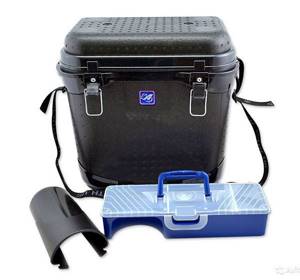
If you decide not to move from hole to hole, a fishing box will serve you well. You can fit bait and tackle in it, as well as a couple of sandwiches for yourself to eat. At the same time, it is strong enough for everyone to sit on it.
The main requirements for it are:
- Strength;
- Light weight.
Scoop
A very necessary device. Without it, the hole will be filled with ice slurry with large fragments, which, you see, will make it difficult to pull the caught fish out of it. Moreover, in good frost, the hole will be covered with ice, and it is better to take a light scoop once again rather than a heavy drill or pick.
When choosing this product, choose the version with the least weight and preferably a wooden handle. So if you accidentally drop it into a hole, it will float on the water.
Bagorik
It is an indispensable assistant for fishing. If your prey is much larger than the hole, you can firmly hook it under the gills with a hook, and then slowly begin to widen the hole in the ice. You can make it yourself, all you need is steel wire, a wooden handle and that’s it.
Feeder
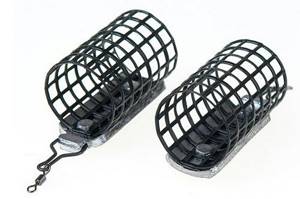
Different types of fish are found at different depths. And in order to feed the species you need, you need a feeder. Most often there are two types of such devices - cone-shaped and rectangular. Using a feeder is not difficult, all you need is to find a rope or fishing line and lower it into the water to the desired depth.
Preparing winter gear
Taking into account the behavioral characteristics of fish species in winter, gear is selected and equipped. Winter girders are successfully used for stationary fishing. Catching pike in winter requires the use of a metal leash, but for catching other freshwater predators, this condition is not necessary.
To actively search for fish, use a winter fishing rod with a nod. This tackle is also suitable for catching live bait in winter.
Successful fishing in clear water is ensured by inconspicuous equipment and a reduction in its bulk.




